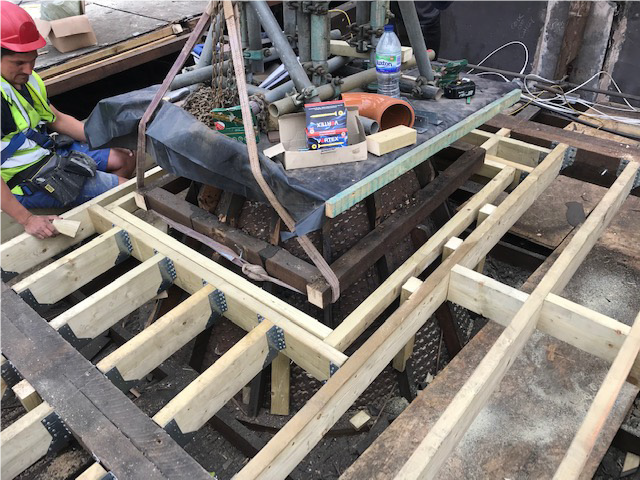
CHURCH RESTORATION PROJECT 2005-19
ST MICHAEL IN THE HAMLET CHURCH RESTORATION PROJECT 2005-19
By Alan Studley, Reader Emeritus, St Michael-in-the-Hamlet Church
Introduction
In 1983 it was agreed to remove the reredos from in front of the east window in order to show the window in its full splendour; since the early years of the 20th century the entire bottom section of six lancets had been hidden from view, adversely altering the proportions of the window and, frankly, making a nonsense of what the stained glass represented. Grant assistance was sought from English Heritage, and the project was completed the following year, the screen being moved to its present position around the west entrance doors to the worship space. The magnificent east window was once again visible in its entirety.
However, it was a condition of the English Heritage grant that we removed the bitumen covering the nave roof. This had been applied at some indeterminate point in the past to try to keep out rainwater, and the rain had successfully been kept at bay. Things were very different when the bitumen was removed; for the next twenty years, rainwater ingress through the nave roof was a serious problem.
At the beginning of the 21st century it was decided to address the problem as part of the first phase of our current restoration project.
Nave Roof and Clerestory
This was such a large phase of the project that, for administrative purposes, it was split into two parts – north and south sides - although both sides of the roof were restored together at the same time. The church was able to obtain grants from English Heritage (£340,000 towards development and delivery costs of £435,000 excluding VAT). Further grants were received from the Historic Churches Preservation Trust (now the National Churches Trust), Allchurches Trust and the Garfield Weston Foundation, and a large number of private contributions were offered including one anonymous donation of £10,000). All payments made in respect of the project qualified for a refund of VAT under the Listed Places of Worship Scheme.
The nave roof consists of two skins of large Welsh slates set on their cast iron frame with a void between them. The idea was that any rain that penetrated the outer skin would be dispersed by the airflow through the void and prevented from getting through the inner skin and into the building. As plausible as the theory seemed, it simply did not work in practice. The church’s architect, working closely with the English Heritage architect for the region, came up with the answer: a watertight roof would be constructed in the void between the slate skins. But first it proved necessary to take away the concrete matrix that had been used to fill all but one of the bays that made up the roof void, in an even earlier attempt to keep the rain out.
Another complication addressed by the project was the way that the nave roof drained on to the lower aisle rooves via the hollow upper sections of the columns that held up the roof. This was remedied by the installation of new gutters and, for the first time in the building’s history, external downspouts at clerestory level.
The remainder of this first phase involved work at clerestory level including fresh lime render to the walls and the total refurbishment and restoration of the cast iron window frames.
Tower Roof and Pinnacles
The tower pinnacles were originally free-standing, the large corner ones on their plinths of cast iron frame and slate sides filled with a matrix of rubble, and the smaller mid-point ones on their stone plinths. Over time the corner pinnacles especially had shifted and had been tied together diagonally with steel ties. This remedy eventually resulted in a degree of instability in the tower structure, particularly at the northwest corner. A small project was undertaken in the early years of the 21st century which involved some stitching to the cracked brickwork, the removal of the upper part of the internal spiral staircase and its enclosure, and the installation of a steel tie around the internal walls of the tower.
At best this solution would only be temporary, and in 2010 it was decided to carry out a project which would stabilise the pinnacles on a permanent basis. This was to mean constructing a stainless steel supporting frame which would be attached to a newly installed collar beam on the top of the tower walls; the frame’s eight legs, projecting upwards, would support the pinnacles and their plinths and ensure they were permanently held in a vertical position. The remainder of the project was to replace the worn out flat steel roof with a pitched roof for better drainage and to refurbish the cast iron balustrades around the top of the tower.
The total cost of the project amounted to £260,000 including VAT, and we received a grant from English Heritage of £199,000. We also received a grant from the Garfield Weston Foundation, and the rest of the cost was met by private donations. However there was a significant complication when it came to reclaiming VAT payments under the Listed Places of Worship Scheme: part way through the project, after our grant from English Heritage had been agreed and we had signed contracts to proceed, the government altered the Scheme by excluding VAT charged on professional fees. This resulted in our having to find an additional £14,000 at very short notice to pay for the work.
Baptistery Roof/North Aisle Roof
In 2015 we were offered a grant under the Listed Places of Worship Roof Repair Fund to carry out urgently required repairs to the part of the north aisle roof above the northwest access and the baptistery. The offer amounted to £110,000 towards agreed costs of £122,000; VAT payments would again be refunded under the appropriate Listed Places of Worship Scheme.
Investigations showed that the stainless steel roof covering was in a poor state, several of the joints having sprung, and needed to be completely replaced. The timber substrate was equally poor with a considerable amount of rot present. The ornamental ironwork at the eaves was to be refurbished and the pinnacles and their plinths were to be made safe at the same time. The work was completed between March and August 2016. When the roof works were complete, the font (which had been removed from the baptistery for the duration of the works) was re-sited to a position in the southeast corner of the nave.
It was quite obvious that the remainder of the north aisle roof was in just as poor condition, as was the rest of the ironwork. Application was made to the Heritage Lottery Fund, and we were offered a grant in March of 2017 of £231,000 against projected costs of £316,000. Grants were also received from Allchurches Trust (£5,000), the National Churches Trust (£20,000), the Garfield Weston Foundation (£15,000) and a local charitable trust which donated anonymously (£20,000). Following investigatory work in 2018 the repairs were carried out between February and September 2019. Drawing on the experience gained from the repairs to the Baptistery end of the roof, there were no unforeseen problems encountered in this part of the project.
